実施日 : 2009年10月22日(木) - 23日(金)
【Press Tour】October 22-23, 2009:Press Tour to Yamagata – Another Japan
投稿日 : 2013年08月22日
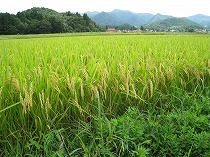
Yamagata - “Another Japan”,
where growth does not mar the happy balance between people and nature
- World-leading R&D of Organic EL, manufacturers’ spirits to create Michelle Obama’s inauguration outfits, and holy mountains with a long tradition of nature worship -
Receiving so much from rich nature, people in Yamagata faithfully live with it paying respect to mountains, rocks, and plants: a long tradition of nature worship.Dr. Edwin O. Reischauer, an U. S. ambassador to Japan from 1961 to 1966, visited Yamagata and named it "the other Japan - the other side of mountain." He admired it for "maintaining a healthy balance between man and nature” and found Yamagata an ideal blueprint of future Japan.
The tour will cover the world-leading R&D of Organic EL as the next-generation lighting fixture lead by Yamagata University, which is expected to contribute to de-carbonization.
Featuring Yamagata’s manufactures extensively, we will visit two small firms that produce world-class high-end products keeping a long tradition of craftsman and get a glimpse of their philosophy of preserving good old traditions as well as pushing the limits of technology.
Dewa-sanzan, or the three mountains of Dewa, (Gassan, Hagurosan, and Yudonosan) are still worshiped as sacred mountains. By touching upon the basis of Yamagata’s spiritual culture which respects harmony between man and nature, we will see “another Japan” of the future.
******************************************
As you can guess from its name, there are many beautiful mountains in Yamagata. More than 70% of its area is covered with forest, which includes the Japan’s largest virgin beech forest. Every city, town, and village in the prefecture has its onsen, or hot spring. While the prefecture is known for producing such a variety of fruits as cherries, peaches, and grapes, it is also famous as the home of rice. Receiving so much from this rich nature, people in Yamagata faithfully live with it paying respect to mountains, rocks, and plants: a long tradition of nature worship.
Dr. Edwin O. Reischauer, during his tenure of office as U. S. ambassador to Japan from 1961 to 1966, visited Yamagata and named it “the other Japan - the other side of mountain.” He admired it for “maintaining a healthy balance between man and nature”, and hoped for a Japan of the future, where there is room for growth but growth which does not mar the happy balance between man and nature.” He found Yamagata an ideal blueprint of future Japan. That is what we should bring into being on the earth as soon as possible.
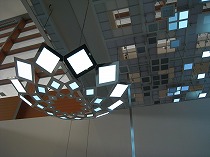
In this environment of lush greenery, the world-leading cutting edge joint R&D, which is expected to contribute to de-carbonization, is under way at Yamagata University, the core organization. Prof. Junji Kido, Ph. D., the inventor of white-color Organic EL, takes the lead in the production of next-generation lighting fixtures using Organic EL. Organic Electroluminescence uses the phenomenon that organic materials emit light in response to an applied electric field. The lighting fixture using the Organic EL makes full use of advantages of thethin film surface emitting device with a low consumption of power. Expected to create a market equivalent to 10 billion yen or more in Japan alone when mass production starts in three years’ time, Organic EL has attracted great attention as a new industry to revitalize the local economy. There are already many manufacturers with expertise in such fields as textiles, electronics, and machinery in Yamagata. This is an attempt for the university and SMEs to create a new local business putting the strength of knowledge and technology together.
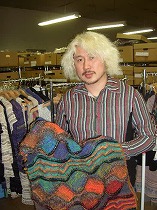 Featuring Yamagata’s manufactures extensively, we will visit two small firms that produce world-class high-end products keeping a long tradition of craftsman. Sato Seni Co., Ltd is a knitwear maker with 100 employees and sells its products to the world’s top class brands including Chanel, Nina Ricci, and Issei Miyake. Remember the impressive Nina Ricci yellow cardigan first lady Michelle Obama wore for the inauguration in January this year? It was made of the world’s thinnest mohair yarn, developed by Sato Seni. In fact, they are continuously inventing special wool yarns which are unique in the world.
Featuring Yamagata’s manufactures extensively, we will visit two small firms that produce world-class high-end products keeping a long tradition of craftsman. Sato Seni Co., Ltd is a knitwear maker with 100 employees and sells its products to the world’s top class brands including Chanel, Nina Ricci, and Issei Miyake. Remember the impressive Nina Ricci yellow cardigan first lady Michelle Obama wore for the inauguration in January this year? It was made of the world’s thinnest mohair yarn, developed by Sato Seni. In fact, they are continuously inventing special wool yarns which are unique in the world.
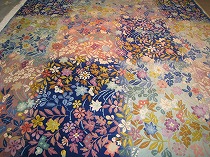 Another example is Oriental Carpet Mills., Ltd., where you can take a close look at Yamagata artisans’ honest work. Nestled among mountains, this simple factory produces high quality hand-woven carpets and supplies them globally to various clients including the Imperial Palace and the Vatican. Hand-weaving a carpet requires so much precise technique that even an experienced worker cannot produce more than 7 centimeters a day. Painstakingly, he/she raises carpet-weaving into a fine art, which looks like a painting. Through reporting on these SMEs, we will get a glimpse of Yamagata’s manufacturers’ philosophy of preserving good old traditions as well as pushing the limits of technology.
Another example is Oriental Carpet Mills., Ltd., where you can take a close look at Yamagata artisans’ honest work. Nestled among mountains, this simple factory produces high quality hand-woven carpets and supplies them globally to various clients including the Imperial Palace and the Vatican. Hand-weaving a carpet requires so much precise technique that even an experienced worker cannot produce more than 7 centimeters a day. Painstakingly, he/she raises carpet-weaving into a fine art, which looks like a painting. Through reporting on these SMEs, we will get a glimpse of Yamagata’s manufacturers’ philosophy of preserving good old traditions as well as pushing the limits of technology.
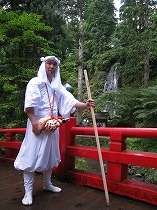 Among beautiful mountains in Yamagata, Dewa-sanzan, or the three mountains of Dewa, (Gassan, Hagurosan, and Yudonosan) are still worshiped as sacred mountains. In ancient times people lived close to nature, thanked nature for its gifts, and nurtured worship of nature in their minds. Dewa-sanzan has the tradition of Shugendo, mountain asceticism, and mountain worship, with its origins dating as far back as 1400 years ago. The Shugendo is an ancient Japanese religion in which nature is worshiped as the god. In the Heian period (794-1185) when Buddhist and Shinto beliefs intermingled, the three mountains were used as a place of learning for plural religions – including the yamabushi, mountain ascetics. The faith that draws people to the three mountains reached its peak in the Edo period (1603-1867), but is quietly present even today. By touching upon the basis of Yamagata’s spiritual culture which respects harmony between man and nature, we will see “another Japan”of the future.
Among beautiful mountains in Yamagata, Dewa-sanzan, or the three mountains of Dewa, (Gassan, Hagurosan, and Yudonosan) are still worshiped as sacred mountains. In ancient times people lived close to nature, thanked nature for its gifts, and nurtured worship of nature in their minds. Dewa-sanzan has the tradition of Shugendo, mountain asceticism, and mountain worship, with its origins dating as far back as 1400 years ago. The Shugendo is an ancient Japanese religion in which nature is worshiped as the god. In the Heian period (794-1185) when Buddhist and Shinto beliefs intermingled, the three mountains were used as a place of learning for plural religions – including the yamabushi, mountain ascetics. The faith that draws people to the three mountains reached its peak in the Edo period (1603-1867), but is quietly present even today. By touching upon the basis of Yamagata’s spiritual culture which respects harmony between man and nature, we will see “another Japan”of the future.
※This press tour has been organized by Foreign Press Center, Japan in cooperation with Yamagata Prefecture and Yamagata University.
【Presentations】
1.Yamagata University Yonezawa Campus: Organic EL R&D (Yonezawa City)
- World-leading Pioneer of Organic Electroluminescence R&D: Collaboration between the university and local SMEs to develop Organic EL lighting fixtures for de-carbonization of the world -
(Prof. Junji Kido, Ph.D., Department of Organic Device Engineering, Graduate School of Science)
Organic Electroluminescence uses the phenomenon that organic materials emit light in response to an applied electric field. Since it can form a surface emitting illuminator and produce various emission colors, the Organic EL has been developed as a flat-panel display for practical use. It was discovered by a researcher in the United States in 1987, but after a decade a Japanese company based in Yonezawa, Yamagata, succeeded in mass-produceing Organic EL flat-panel displays, the first in the world. Those were used for the display of car stereo. Unlike liquid crystal, it is a self-luminous device, which requires no back light system, the film of the emitting layer is as thin as 0.1 micrometers. In 2007 Sony produced and sold Organic EL television sets with a thickness of 3 millimeters and vivid contrast images. In recent years, Organic EL has attracted great attention as next generation lighting fixture that makes full use of the advantages of the thin film surface emitting device with high luminous efficiency and low consumption of power.
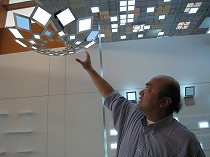 At Yamagata University, Prof. Junji Kido Ph. D., the world’s first inventor of the white-color Organic EL, takes the lead in the production and utilization of the next-generation lighting fixtures using Organic EL. At present, his goal in three years’ time is to halve the power consumption from the current level, which is as equal to one fluorescent bulb and one fifth of an incandescent bulb. The fact that Organic EL lighting fixtures contain no harmful substance such as mercury also allays concern about environmental pollution. Since they are environmentally-friendly and contribute to decarbonization, the Organic EL lighting fixtures are thought to have a big potential in many fields.
At Yamagata University, Prof. Junji Kido Ph. D., the world’s first inventor of the white-color Organic EL, takes the lead in the production and utilization of the next-generation lighting fixtures using Organic EL. At present, his goal in three years’ time is to halve the power consumption from the current level, which is as equal to one fluorescent bulb and one fifth of an incandescent bulb. The fact that Organic EL lighting fixtures contain no harmful substance such as mercury also allays concern about environmental pollution. Since they are environmentally-friendly and contribute to decarbonization, the Organic EL lighting fixtures are thought to have a big potential in many fields.
Predicting that "a market equivalent to 10 billion yen or more will be created in Japan alone, and much more outside when mass production starts in three years’ time", Prof. Kido launched "Yamagata Organic Electronics Valley Initiative" in collaboration with local manufacturers in 2003. Along with the Initiative, they established a maker of Organic EL lighting panels named Lumiotec last year and a Yamagata University start-up firm for designing and retailing Organic EL lighting fixtures, namely Organic Lighting, which in July this year. Both are based in Yonezawa and steadily moving to fruition in the near future. Prof. Kido will brief us on Organic EL R&D and show us various prototype lighting samples using 400 panels in total, whose luminous efficiency reaches the world’s highest standard.
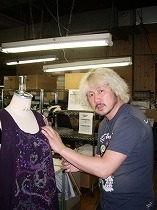
Founded in 1932, Sato Seni Co., Ltd. is a manufacturer of spun yarns and knitwear with 100 employees and sells its products to the world’s top class brands including Chanel, Nina Ricci, Prada, and Issei Miyake. Remember the impressive Nina Ricci yellow cardigan first lady Michelle Obama wore for the inauguration in January this year? It was made of the world’s thinnest 40 count mohair yarn, which only Sato Seni could produce.
In fact, it is continuously inventing its original special wool yarns which are unique in the world: 50 count micro yarn; light and strong specialty yarn using washi (Japanese paper) as its core and covered in wool; a colorful dyed yarn which shows gradation. Surprisingly, these unique yarns are produced not by cutting-edge spinning machines but by old manual machines invented 50 years ago, that can be adjusted and converted by human hands and senses.
Earlier, as a knitwear maker, Sato Seni used to be a subcontractor to major makers, but some years ago it launched its own apparel brand which manages all the process of production, from yarns to end products. The market responded strongly andhighly valued its products which reflect the maker’s commitment to quality, created through the production which is consistently done in Japan from the beginning to the end. In September 2009 it opened its first retail shop in Tokyo.
The third generation president Masaki Sato, talented and tireless, who succeeded in creating state-of-art products in his small factory and building his own production and retail system, will present manufacturers' spirit of pushing technology to the limits.
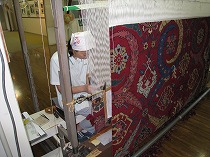 Located in Yamanobe-machi, a small town among mountains, to the west of Yamagata City,Oriental Carpet Mills, Ltd. is a small manufacturer with 40 employees. Although its simple wooden factory reminds us of an old elementary school built in the Taisho period (1912-26), it is a place where high quality hand-woven carpets and rugs are made and supplied to a wide range of clients including the Imperial Palace, the State Guest House in Akasaka, Tokyo, the Vatican, and Roosevelt Memorial Hall in Washington D.C..
Located in Yamanobe-machi, a small town among mountains, to the west of Yamagata City,Oriental Carpet Mills, Ltd. is a small manufacturer with 40 employees. Although its simple wooden factory reminds us of an old elementary school built in the Taisho period (1912-26), it is a place where high quality hand-woven carpets and rugs are made and supplied to a wide range of clients including the Imperial Palace, the State Guest House in Akasaka, Tokyo, the Vatican, and Roosevelt Memorial Hall in Washington D.C..
Hand-weaving a carpet requires so much precise technique - weaving thread one by one as illustrated in the drawing - that even an experienced worker cannot produce more than 7-8 centimeters a day. In the end the finished carpet is soaked and brushed in an alkaline solution, that is called “mercerizing”, a special technique to add to the end product an elegant sheen and smooth fed which will increase as the carpet gets older.
 In 1935, the founder of Oriental Carpet Mills invited seven craftsmen from China to introduce the techniques of hand-woven carpets to Yamanobe, where a textile industry flourished at the time, and started production of high quality carpets and rugs. Harmonizing a technique from China with Japanese skills and sense of beauty, the company has created its original technique and quality that are highly valued all over the world.
In 1935, the founder of Oriental Carpet Mills invited seven craftsmen from China to introduce the techniques of hand-woven carpets to Yamanobe, where a textile industry flourished at the time, and started production of high quality carpets and rugs. Harmonizing a technique from China with Japanese skills and sense of beauty, the company has created its original technique and quality that are highly valued all over the world.
In 2006, it was selected as one of "300 of Japan's Dynamic Monozukuri (manufacturing) SMEs" by METI, and from that year to 2008 participated in "Maison & Objet" in Paris. The tour will visit this small factory, nestled among the mountains, and learn its philosophy of production: "whole-heartedness" that, it believes, is what world consumers want.

Ms. Mieko Yoshimura won election as Yamagata’s Governor for the first time in January 2009 defeating the incumbent becoming the sixth women Governor in Japan. Focusing on people in Yamagata and their life, she tries to tackle the shrinking and aging population of the prefecture, which dropped from 1.2 million in 2007. It is also rapidly aging as the current data show that one in four people is aged 65 or older and the birth rate is only 1.42. Her manifesto for the election earlier this year includes the population issue and extends to the unemployment worsened by the recent global recession. We will ask Governor Yoshimura how she can resolve these problems, what to deliver to Yamagata, and what to expect from the Hotoyama Government.
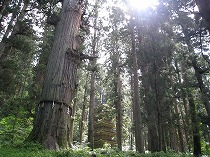 Dewa-sanzan, the three mountains of Dewa, is the collective name for Gassan, Hagurosan, and Yudonosan, mountains that are regarded as sacred. In ancient times people believed that ancestral spirits lived in mountains and gave water to protect them – they lived in nature with a feeling of awe.
Dewa-sanzan, the three mountains of Dewa, is the collective name for Gassan, Hagurosan, and Yudonosan, mountains that are regarded as sacred. In ancient times people believed that ancestral spirits lived in mountains and gave water to protect them – they lived in nature with a feeling of awe.
Dewa-sanzan has a tradition of Shugendo, mountain asceticism, as well as mountain worship, with its origins dating as far back as 1400 years ago. Shugendo, literally “the path of training and testing”, is an ancient Japanese nature religion. Buddhism began to spread throughout the country in the Heian period (794-1185). During the age when Buddhist and Shinto beliefs intermingled, the three mountains were used as a untain of learning for many religions. The faith that draws people to the three mountains reached its peak in the Edo period (1603-1867), but remains unchanged even today.
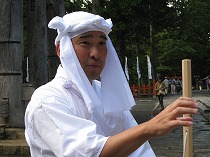
In the Shugendo, Hagurosan stands for the present, Gassan the past, and Yudonosan the future. Therefore, to make a pilgrimage touring the three mountains means to travel from the past, through the present to future, and it is believed that people are reborn by doing so.
Our tour will visit Hagurosan with a local guide, Mr. Shuetsu Ito, an official from Tsuruoka City and an active yamabushi (Shugensha), that is a person who practices Shugendo. We will enjoy soaking in nature and silence and learn about the basis of the spirit and culture of Yamagata.
<Places to visit in Hagurosan>
- Haraigawa River and Suga-no-taki waterfall
Flowing down from Gassan, the Haraigawa River with a red lacquered bridge was used as the pure water where pilgrims to the three mountains bathed before climbing the mountains.
- Five-story pagoda designated as a National Treasure
Built in the Heian period, about 1000 years ago (some time in the 920’s), on the orders of Masakado Taira, then rebuilt about 600 years ago, the pagoda still stands gracefully in the midst of cedar trees.
- Jiji-sugi, the “old man cedar”
Standing next to the five-story pagoda, this old cedar is said to be 1000 years old and is designated as a national natural treasure.
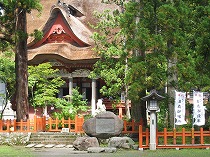 - Sanjin gosaiden, or the worship hall to the three gods at the summit of Hagurosan
- Sanjin gosaiden, or the worship hall to the three gods at the summit of Hagurosan
With the striking thatched roof, 28 meter high and 2.1 meters thick, and a splendid red-lacquered structure that remains a characteristic of the age when Buddhist and Shinto beliefs intermingled, the shrine jointly enshrines the three gods of Gassan, Hagurosan, and Yudonosan. The pond in front of the shrine, called "kagami ike", or mirror pond, has been revered as a holy pond from ancient times, the center of the faith. Many copper mirrors that people threw in as offerings in the Heian, Kamakura, and Edo period, were discovered in the pond.
- Saikan, a pilgrims’ lodge
Keeping the traditional style of vegetarian cuisine in Hagurosan, the lodge serves meals with ingredients including mountain vegetables and bamboo harvested at the foot of the three mountains of Dewa. It still respects the old way of seasoning. This kind of food was served to Matsuo Basho, the famous poet of the Edo period, when he came to visit the Saikan on his famous trip to northern Japan, “Oku-no-Hosomichi”.
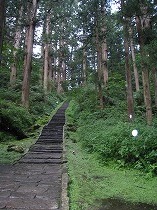 - Pilgrimage road lined with Japanese cedar trees, sugi
- Pilgrimage road lined with Japanese cedar trees, sugi
Both sides of the 1.7-km pilgrimage road to the summit are lined with ancient cedar trees and thelong stone staircase has 2,446 steps in total. You feel the crisp air and mysterious atmosphere in total silence. A famous French travel guide book, "Michelin Green Guide Japon" has awarded the road its highest ranking of three stars.
【 Tour itinerary and application details 】
1. Itinerary: October 22 -23, 2009
<Day 1: Thursday, October 22>
07:05 Meet at Tokyo Station (on the platform of Tohoku Shinkansen)
07:16 Leave by Yamagata Shinkansen Tsubasa 103
09:30 Arrive at Yonezawa Stationby (Move by chartered bus)
09:45-11:20 Cover Yamagata University "R&D of Organic Electro-Luminescence" at Uesugi Joshien
- Meet Vice President Kiyoto Koyama
- Presentation on OEL by Prof. Junji Kido
- Visit OEL lighting fixture exhibition at Denkoku-no-mori
12:30-13:45 Lunch at “Yuki no Sato Sansan”, an organic farm restaurant (Takahata-cho)
15:15-17:00 Visit Sato Seni Co., Ltd. (Sagae City)
-Briefing by President Masaki Sato and factory tour
17:45 Arrive at Yamagata Grand Hotel
18:15-18:45 Meet with Governor of Yamagata Prefecture Mieko Yoshimura
18:45-20:15 Buffet dinner with the Governor Yoshimura
(Stay overnight at Yamagata Grand Hotel)
<Day 2: Friday, October 23>
08:45 Leave hotel by chartered bus
09:30-11:00 Visit Oriental Carpet Mills, Ltd. (Yamanobe machi)
12:30-14:00 Visit Dewa Sanzan - Hagurosan (Tsuruoka City)
(14:00-15:00 Lunch at Saikan (“shojin ryori”, or vegetarian food)
17:10 Arrive at Shonai Airport
18:00 Leave by ANA flight 900
19:00 Arrive at Tokyo Haneda Airport
2. Qualification: Bearer of Gaimusho Press Registration Card
3. Expenses: 13,000 yen per person including transportation, accommodation, and meals
4. Participants: Limited to the first 10 applicants on a first-come first-served basis.
(Only one reporter and one photographer from each company, but two participants from each TV team will be acceptable.)
5. FPCJ Contact: Ms. Yoshida and Ms. Koizumi (Tel: 03-3501-3405)
6. Remarks:
Yamagata Prefecture, Yamagata University, and FPCJ will not be liable for any inconvenience, trouble or accident that might occur in the course of the tour.


